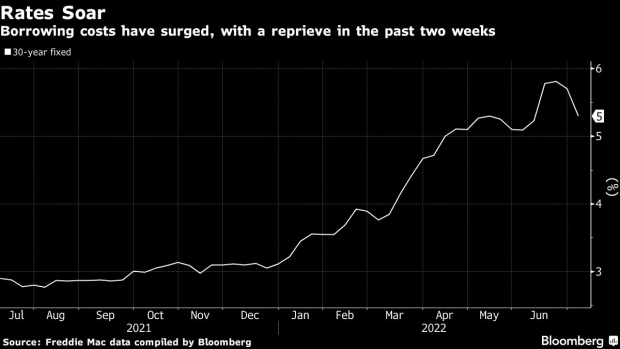Jul 12, 2022
Wall Street Traders Set for $27.8 Billion Haul From Wild Markets
, Bloomberg News

(Bloomberg) -- The biggest U.S. banks are poised to report a double-digit increase in trading, the result of big market swings spurred by recession fears, soaring inflation and global turmoil, including Russia’s invasion of Ukraine.
Trading revenue at the five biggest Wall Street firms likely climbed 16% to $27.8 billion in the second quarter, driven by fixed-income desks which are expected to have brought in a combined $16.4 billion, according to analyst estimates compiled by Bloomberg. That increase, along with higher net interest income tied to Federal Reserve rate hikes, should provide a boost to earnings, countering a hit from slowdowns in the companies’ investment-banking and mortgage businesses and a drop in valuations at their wealth-management arms.
“Volatility is basically our friend,” Andy Morton, global head of markets at Citigroup Inc., said at an industry conference last month. “And we’ve not just had volatility in one or two asset classes, or one or two things to focus on,” he added, citing central-bank rate surprises and swings in commodity prices and foreign exchange.
JPMorgan Chase & Co. and Morgan Stanley kick off earnings season Thursday, followed by Wells Fargo & Co. and Citigroup on Friday, and Bank of America Corp. and Goldman Sachs Group Inc. next week.
Here are other key areas to watch as quarterly results are announced:
Investment Banking
Investment-banking revenue may have sunk 44% in the second quarter from a year earlier, according to analysts’ estimates as of Monday, with the same market turmoil that’s boosting trading activity also stymieing dealmaking. Analysts are expecting a 74% drop in revenue from equity issuance, a 36% decline from debt issuance and a 16% slump from advising on mergers and acquisitions.
“The investment-banking environment for fees has been very challenging this quarter, particularly equity capital markets,” Bank of America Chief Financial Officer Alastair Borthwick said last month, noting that the trend applies across Wall Street. He also warned of some leveraged-finance writedowns.
Read more: Wall Street Faces Billion-Dollar Losses on Sinking Buyout Debt
Interest Income
The Fed’s rate hikes are expected to provide a boost to net interest income, a key source of revenue for the biggest banks. The six largest firms likely pulled in $52.7 billion, up 15% from a year earlier. Lenders have been making increasingly rosy projections for how much they will earn in NII this year amid expectations that rate hikes will continue. In May, JPMorgan raised its 2022 outlook for the second time this year, saying it expects the metric to increase 26% from 2021.
This quarter will “reflect the benefit of higher interest rates,” Credit Suisse Group AG analyst Susan Katzke wrote in a note to clients. “The lift in interest rates is the strongest supporting positive to the fundamental picture.”
Credit Provisions
Analysts are expecting all the major commercial lenders to set aside money for potentially soured loans, a turnaround from a year ago, when earnings were padded by reserve releases. The biggest banks earmarked tens of billions of dollars at the onset of the Covid-19 crisis for potential loan losses that never materialized, which then boosted results throughout 2021. Now, with more loan growth and a worsening economic outlook, JPMorgan, Bank of America, Wells Fargo and Citigroup are expected to report a combined $3.3 billion in provisions for credit losses in the second quarter.
Still, at conferences last month, executives at the biggest firms said that credit quality remains strong. Investors will be eager for updates on whether firms are starting to see signs of trouble for consumers and businesses.
Mortgage Business
Mortgage rates surged in the second quarter on the Fed’s rate hikes, cooling demand in what had been a red-hot housing market. Major lenders including JPMorgan and Wells Fargo have been laying off and reassigning staff in their mortgage divisions, and Wells Fargo CFO Mike Santomassimo told investors last month that income from his bank’s mortgage business could fall by half in the second quarter.
“As you would expect, you’re seeing the refinance volume fall significantly -- no surprise,” Santomassimo said at the time. “You’re still seeing some activity in the purchase market, which is good, but affordability does start to become an issue as rates continue to increase.”
Read more: Mortgage Lenders Turn ‘Desperate’ as Soaring Rates Roil Industry
Economic Outlook
JPMorgan Chief Executive Officer Jamie Dimon caused a stir last month when he warned of an economic “hurricane,” kicking off a slew of weather analogies from Wall Street’s top brass. Shareholders will be looking for executives’ latest views on the economy, and the potential impact on their firms’ earnings.
“There’s just one word that investors are looking for, and that one word is ‘recession,’” Wells Fargo analyst Mike Mayo said in an interview. “What’s interesting is how banks are likely to vary in how they’re going to reflect a recessionary economy.”
©2022 Bloomberg L.P.





